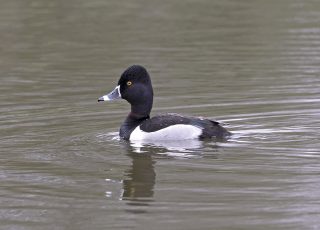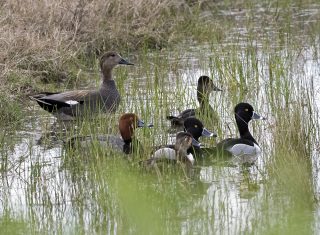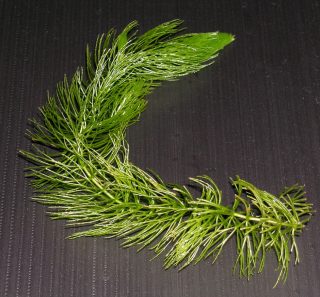
This male Ring-necked Duck is a beautiful bird. Ring-necked Ducks are often found on small ponds during the winter. Their chief requirement is plenty of submerged aquatic vegetation upon which to feed. Robert Benson photo.
Our Lucky Duck Is a Happy Duck!
One cold morning not too long ago we noticed something gray and hunched on the bank. It didn’t move so we assumed it was something inanimate, perhaps a bag that the wind had blown there. Then it shifted a bit. One minute it looked like litter; the next it was a bird! With our binoculars, we confirmed that the “bag” was a Great Blue Heron. It was so still and focused as it hunted, that it probably looked like a big stick to the frogs it was hunting.
Since it has been a cold winter in South Texas, we figured there was little food in the pond to attract birds. I thought all the frogs had long since buried themselves in the mud. The pond is tiny and quite shallow. It is not a stock tank. We have no livestock! We maintain this little pond simply as a water source for wildlife.
However, no body of water stays empty for long. The wind blows in seeds. As birds and animals visit, seeds and bits of plants drop off their feet into the water. I confess to planting some Clover Fern around the pond edge. And, I did put a lovely green strand of hornwort (from my overloaded aquarium) in the pond one summer. All these actions have resulted in a particularly overgrown watering hole.
The cattails were the worst. “Cattails for the pond can be both a headache and a delight” one website suggests. Those lovely “velvety tails” on the plant are seedheads with thousands of tiny seeds each with its own parachute. A good wind can blow them for miles. When they land in the mud or water of any wetland, they sprout. Each individual plant soon sends out rhizomes. A few cattails can become a forest in a single growing season. My husband spent two days last summer grubbing out the cattails. He was not happy doing it.

Small ponds often host several species of ducks. Here, from left to right, are a Gadwall, a Redhead, and four Ring-necked Ducks (two males and two females.) Robert Benson photo.
He had a few choice words for the mass of aquatic vegetation clogging the water too. “Coontail” he called it. I recognized it as the hornwort I had introduced into the pond. The middle of the pond is perhaps three feet deep. Three feet deep in coontail/hornwort that is! He raked out as much of that as he could, but we both knew it would grow back.
Actually, I think coontail (Ceratophyllum demersum) is a good native plant for a pond. Texas AgriLife Extension Service describes coontail (or hornwort) as a “dark, olive green, rootless, submerged, perennial plant that often forms dense colonies.”
Still, coontail is not without merit. Submerged portions of all aquatic plants form habitats for many kinds of macro- and micro-invertebrates. These in turn provide food for all sorts of vertebrates (fish, frogs, turtles, ducks, etc.) In fact, Texas AgriLife points out that “the fruits of coontail are consumed by ducks and are considered a good wildlife food.”
We wanted ducks to come to our pond, so we gave up fighting the coontail. Some species of wintering ducks love small, well-vegetated ponds. We have had a few Gadwalls and American Wigeons in winters past. What would arrive this year? We waited and we watched.
We finally observed a duck on the same day we saw the hunting Great Blue Heron. Unlike Gadwalls and wigeons which are “tip-up” or dabbling ducks, this new duck dove to get food. It was a beautiful male Ring-necked Duck.
Ring-necked Ducks do have a chestnut colored ring around the base of their neck, but it is not obvious. Someone examining museum specimens must have named it. In the wild, the duck is a “sharply marked bird of gleaming black, gray and white.” It has a white ring around the black nail (tip of the bill) and a white edge to the bill where it meets the bird’s head. These striking markings can easily be seen with binoculars. Experts also suggest you look for the bird’s peaked head shape as an identifying feature.

Coontail (also known as hornwort) is a common aquatic plant that is an excellent food for wildlife. Wikimedia Commons photo.
The Ring-necked Duck is one of six species in the genus Aythya, the diving ducks. They dive to the bottom of lakes and ponds to grab seeds, vegetation, snails, and possibly insects. If the water is shallow, Ring-necks may dabble feed at the surface. Although they can be found on large lakes, Ring-necked Ducks do not mind being on small bodies of water. Their main requirement is plenty of food, i.e. aquatic vegetation. This duck got really lucky landing on our pond. It is chock-a-block with coontail!
In fact, our lucky duck seems to realize his good fortune. He has not left the pond for ten days! I have to think that he is happy here and is surviving on a steady diet of coontail. Maybe he will stay all winter!
Column
